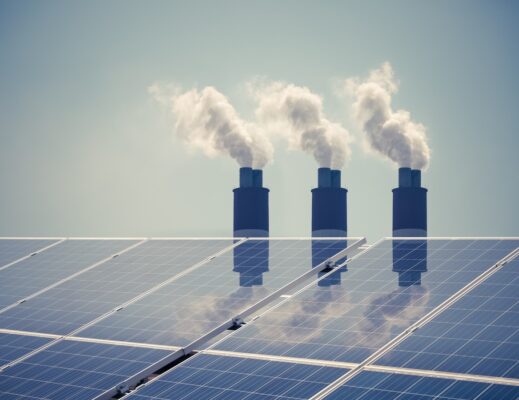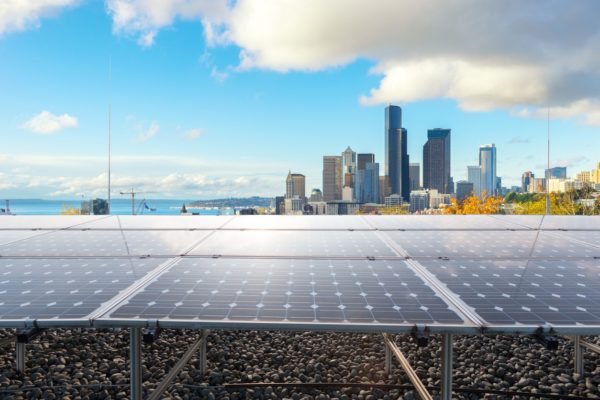
The owners and operators of solar power generating facilities, such as photovoltaic panels or solar thermal power plants that concentrate solar energy using mirrors or lenses, are involved in this industry. This sector only deals with utility-scale solar energy rather than distributed energy.
What Is Industrial Solar?

Many industrial processes, including food processing, water desalination, mineral processing, increased oil recovery, and chemical manufacture, can all be heated by solar energy. This can be accomplished by utilizing resistive heaters or heat pumps powered by photovoltaic panels and concentrating solar-thermal power (CSP) technology. Solar-thermal energy is used for industrial processes when employing mirrors to direct sunlight onto a receiver, which can readily rise to higher temperatures than electric heaters.
Since CSP can achieve a wide range of temperatures, from relatively low-temperature food production procedures to chemical processes that require very high temperatures, it is well suited for various industrial uses.
According to the Energy Information Administration, the Industrial sector accounted for 32% of total US energy consumption and 35% of all end-use energy consumption in 2019. The US Department of Energy Solar Energy Technologies Office seeks to establish a carbon-free energy sector by 2050, and progressing solar technology for industrial processes helps achieve these aims.
Market Dynamics
Drivers
The development of photovoltaic-based power distribution systems has greatly enhanced manufacturer competitiveness. Also, due to the demand-driven nature of the business, solar module prices vary greatly between regions of Europe and Asia-Pacific.
The prices of solar panels have decreased due to reduced profitability for module makers and market acquisition pressures. Also, the fluctuating price of silver, a key component of solar modules, fuels the demand for solar panel installations and supports the expansion of the solar energy sector.
Restraints
Reliability, overall production, and competitiveness have a minor impact on adopting PV system technology. Also, the growth of the solar energy business is constrained by geographic latitudes and general meteorological conditions, particularly in areas that frequently see winter and rain.
Opportunities
To expand the capacity of photovoltaic (PV) systems to displace the current conventional sources, photovoltaic storage systems must be developed. The adoption of a storage grid is anticipated to expand along with the need for PV installations, which will feed the demand for lithium-ion batteries for solar energy storage and propel the expansion of the solar energy market.
Due to increased solar panel installations and use, the amorphous silicon cells market is anticipated to grow the fastest. Also, because more affordable solar panels are being produced, the demand for copper indium gallium selenide (CIGS) is anticipated to rise during the projection period.
Additionally, during this period, the demand for cadmium telluride in the solar energy industry is expected to expand due to low-cost production and improvements in solar module efficiency.
Constraints on the Commercial and Industrial Solar Market

As you start reading about the commercial solar industry, one of the recurring themes is that it hasn’t expanded nearly as quickly as utility-scale solar. According to PV Magazine, commercial and industrial (C&I) solar markets have been relative difficulty for solar companies to penetrate.
Cost of Commercial Electricity
One factor that can make the economics of solar a little more challenging is the historically lower cost of commercial electricity. According to the US Energy Information Agency, the C&I sector has difficulty competing against domestic electricity prices, which are often 15% or cheaper per kilowatt-hour.
The average energy price in the United States in February 2021 was 11.9 cents per kWh for business customers, according to the US Energy Information Administration.
Convincing Building Owners To Purchase
Another obstacle has to do with the fact that many business buildings’ occupants are not the owners of the structures, because of this “split incentive,” building owners who might choose to install solar are frequently not the ones who are responsible for paying the utility bills, which reduces their motivation to do so.
Complex Commercial Financing
Moreover, financing is more difficult to obtain and less available in the C&I solar market. However, today this is starting to change. There are more successful projects for lenders to consider when evaluating risk.
Additionally, Solar Power World notes that “Commercial solar and now community solar is expanding beyond bureaucratic budgetary limitations by systemizing platforms for the private sector, consumers, and third parties to participate with and invest in energy infrastructure assets.”
Adopting power purchase agreements is one of the main factors facilitating finance (or PPAs). PPAs have allowed investors to shoulder the burden of high upfront commercial solar expenses while consumers gradually pay for the system.
Other Barriers
A National Renewable Energy Laboratory (NREL) research lists “contracting issues, the mismatch in building lease and PV finance conditions, and high transaction costs relative to project sizes” as additional obstacles.
Solutions to Commercial and Industrial Solar Barriers

In this industry, many of the difficulties have already been overcome. Commercial solar projects can be organized in many ways that divide the costs and benefits among building owners and renters to suit various requirements, according to a white paper by the SolarKal and Solar Energy Industries Association (SEIA). They also highlight that solar energy is cost-competitive with utility electricity and that various financing mechanisms are available to meet the interests of the parties involved.
Commercial PPAs are an excellent choice for small businesses and NGOs that want solar benefits, but cannot pay the initial fees, even if those costs are frequently almost negligible compared to the offset of lower energy bills.
Current Market Scale

Approximately 1,286 megawatts (MW) of solar business capacity were installed in 2019, with two-thirds of all corporate capacity installed only since 2015, according to a Solar Energy Industries Association report. The study analyses more than 38,300 commercial solar projects totaling more than 8,300 megawatts (MW) across 43 states, or almost 70% of the nation’s installed commercial capacity.
In other words, enough commercial solar energy is installed to power 1.6 million residences. Despite bigger project sizes, the commercial and industrial industry still lags behind the utility-scale market. Non-residential solar, another phrase frequently used to describe this business, made up 24% of all installed capacity in the United States as of 2016, according to the National Renewable Energy Laboratory.
Contact Coldwell Solar for Industrial Solar Solutions
The market for solar energy was valued at $52.5 billion globally in 2018 and is anticipated to increase at a CAGR of 20.5% from 2019 to 2026 to reach $223.3 billion.
Solar energy is the radiant energy that the sun emits; it is captured using various methods, including photovoltaic cells, solar heating, etc. It is a practical renewable energy source for addressing the rising global warming caused by the emission of greenhouse gas.
The solar energy market is primarily driven by increased environmental deterioration and the availability of government subsidies and tax breaks to install solar panels. Also, the reduced water footprint of solar energy systems has raised the demand for them in the industries that generate electricity.
Solar cell demand has significantly increased due to an increase in rooftop installations, followed by an increase in solar applications in the architectural industry. Furthermore, it is projected that using parabolic troughs and solar power towers would increase the need for concentrated solar power systems.
Do you have further questions regarding the state of the industrial solar market? Looking to start your next commercial or industrial solar installation project? Contact us for more information.


